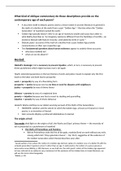Summary
Summary Latin Didactic: The Golden Age myth in Hesiod, Aratus, Virgil, Lucretius, Ovid
- Course
- Institution
A discussion of the use of the Golden Age myth in: - Hesiod's Works and Days - Aratus' Phaenomena - Lucretius' De Rerum Natura - Virgil's Georgics - Ovid's Ars Amatoria
[Show more]



